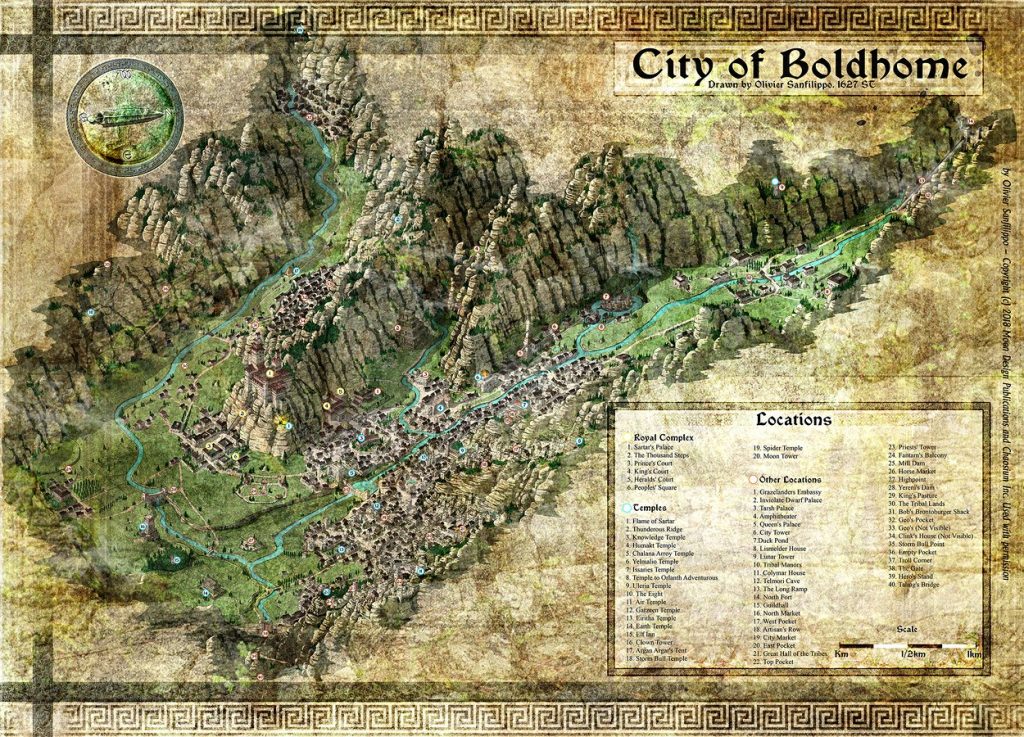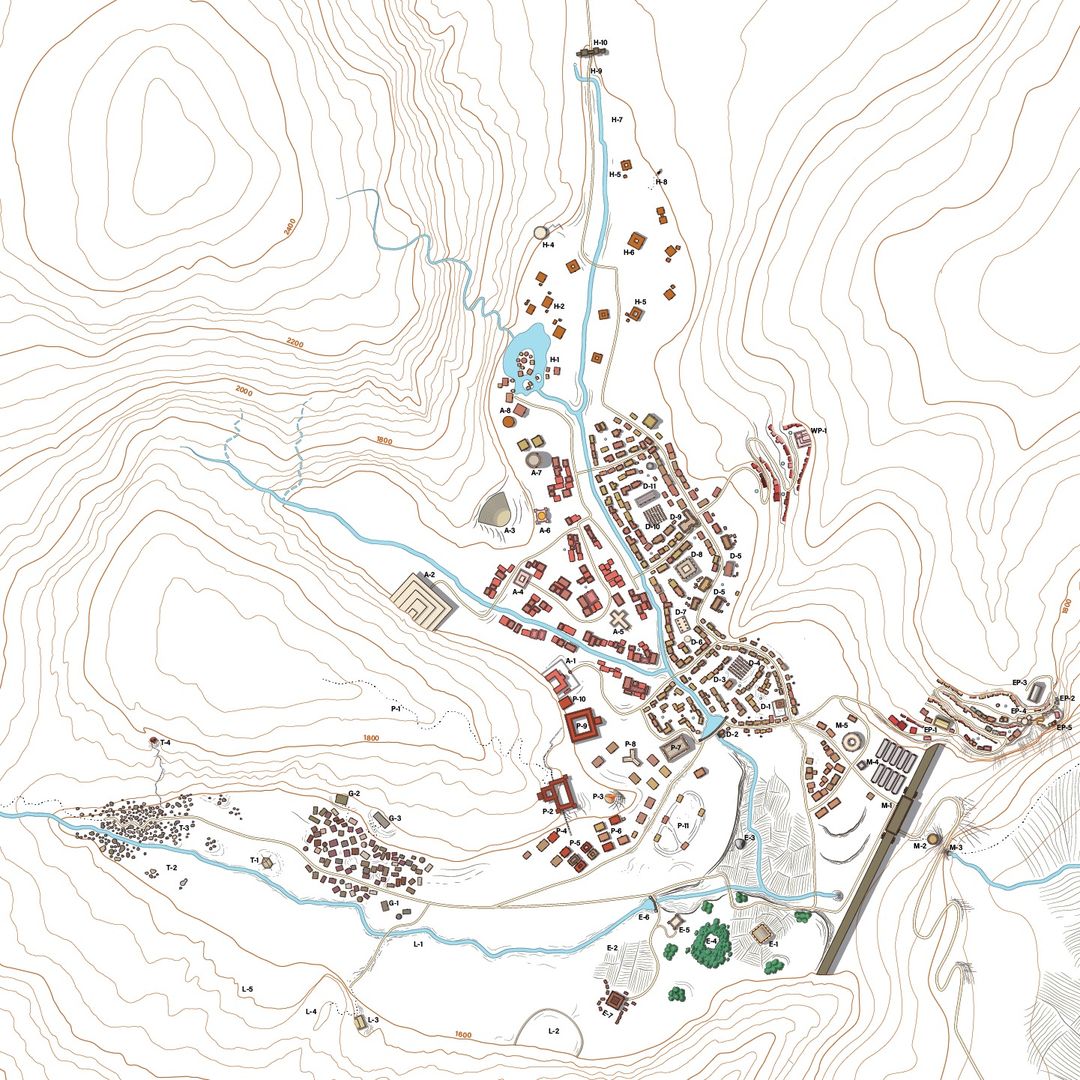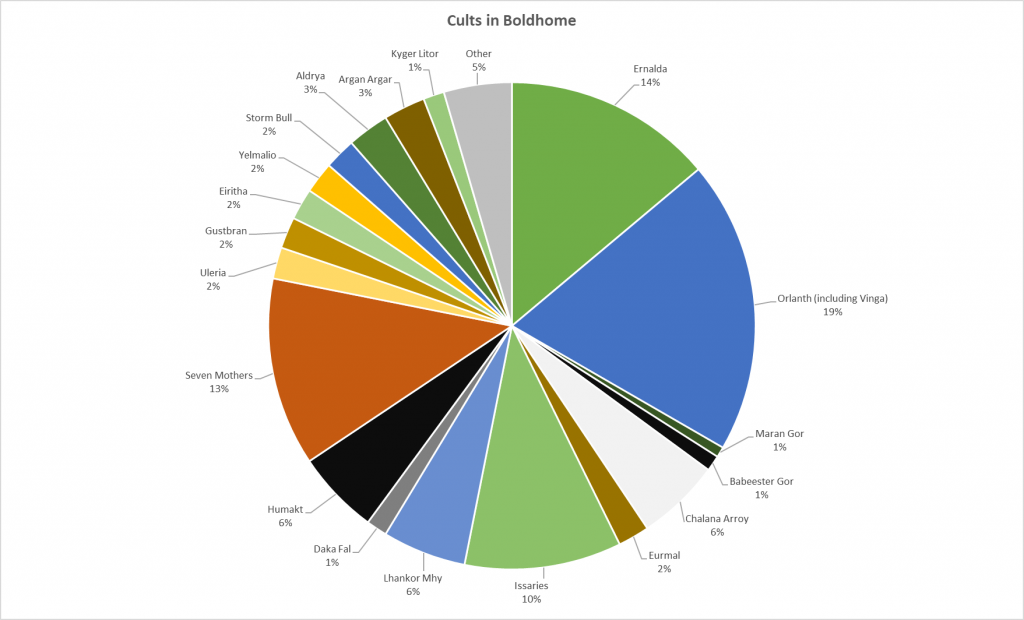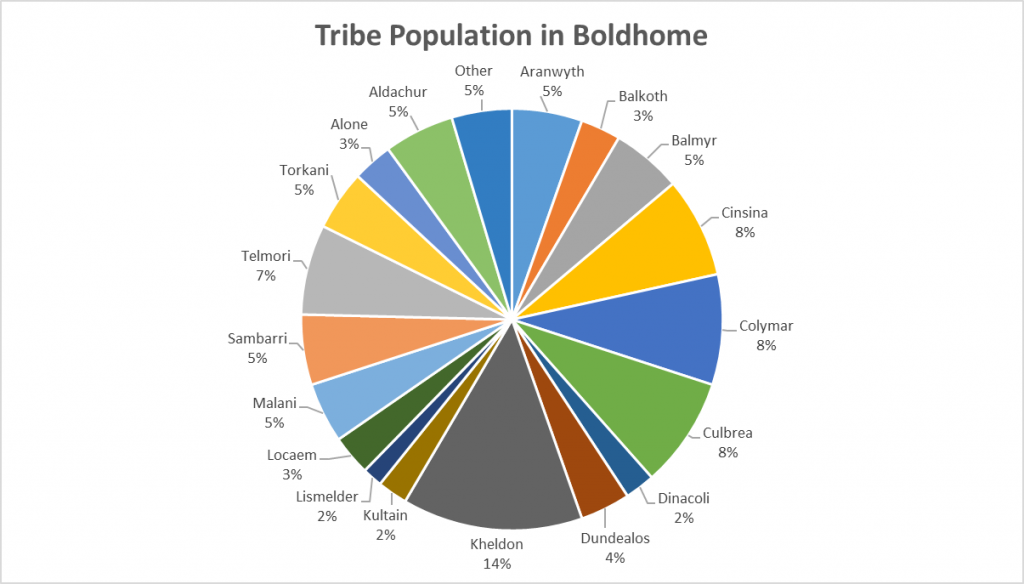
The capital of Sartar, this city is built high above the plains in a split valley amid peaks sacred to Orlanth and his pantheon. It is the biggest city in Sartar, with a population of about 10 000.1Jeff R. 16 Jan 2023 The city serves as the political and religious center of the kingdom, and a center of trade and learning. Following the Dragonrise, Kallyr Starbrow liberated Boldhome and was acclaimed Prince of Sartar by the assembled free peoples. Varanis and Berra own a house here.
Boldhome is a diverse and cosmopolitan city, far more than most Gloranthan settlements. There are young, unmarried warriors from the Adventurous cult, caravanners and merchants from all over, veteran Humakti warriors, Earth women with their snakes, tattooed Thunderers, Sun Dome pike men, Axe Maidens, dancing Earth Shakers, Seven Mothers mystics, hazia fiends, and poets, Eurmali clown societies, Healers of the White Lady, bearded scribes, devotees of Love, Storm Bull cultists ranting about the White Bull, potters and red-smiths with their kilns, cattle women and Animal Nomads, mounted Pure Horse People, the occasional elf or troll, and even dragonewts. There’s a cacophony of music, song, shouts, and tongues – Tradetalk as nearly as common as Sartarite, and Esrolian, Praxian, and New Pelorian can almost always be heard. There are dancers, sights, and smells; spices from the Holy Country and beyond, braying Praxian beasts, incense and hazia, wine, and grilled meat.
Jeff R. (17 June 2022)

The Temples of Boldhome
Boldhome has “great temples to Orlanth, Ernalda, and Issaries, major temples to Chalana Arroy, Humakt, Lhankor Mhy, Storm Bull, and the Seven Mothers, minor temples to Aldrya, Aranea, Argan Argarn, Eiritha, Eurmal, Gustbran, Kyger Litor, Uleria, and Yelmalio, and shines to Asrelia, Maran Gor, Babeester Gor, Donandar, Lanbril, Ty Kora Tek, Voria, Yelm, and several Daka Fal lineages – plus likely more.”
Jeff R. (8 May 2023)
Air Temples: There is a Great Temple to Orlanth, as well as temples to Orlanth Thunderous (East Pocket), Orlanth Adventurous (West Pocket, also includes Vinga), Orlanth Rex (Palace), and Sartar (Palace).2Vinga and Orlanth Rex are additions from our game and don’t appear in the published material yet, but really… for Kallyr’s city, they make sense!
Earth Temple: Ernalda’s Great Temple dominates the Earth Quarter. It is headed by Kalis, an Esrolian import.
Eiritha Temple: A minor temple to the Herd Goddess, probably close to the Earth Temple and the pastures?
Clown Tower: The only public temple of Eurmal the Trickster in Dragon Pass stands near to the Earth Temple.
The Hospital: A major Temple to Chalana Arroy stands near the Prince’s Palace. Headed by Beneva, the Sister of Mercy, this temple has a Healing Dragon associated with it.
Temple of Humakt: Berra has to write this one.
The Market: The Issarian Temple both is the Market and looks out over it. This is the heart of Boldhome for most people outside the palace. (Hmmm. There are actually two Issaries temples and two markets and I know this from the draft, but I need to see if it’s public knowledge.)
The Library: The Knowledge Temple is a major temple of Lhankor Mhy and is one of the largest and most important of the Third Age Libraries.3Alongside Jonstown (Jeff R. 1 Aug 2021)
Sun Dome: A minor temple to Yelmalio, the Sun Dome Temple gleams down over the city from north of the palace. Lord Ebron leads the 150 worshippers in Boldhome. There’s another temple at Runegate.
Shrine of Elmal: A small shrine at the foot of the Thousand Steps.
Storm Bull: High on the cliffs and well away from the general populace, stands the Temple of Storm Bull. The distance and height help protect the city when the rituals get a little too… Storm Bull.
Ulerian Temple: A minor temple to Uleria, found near the Market. There are several rooms here, including large bathing rooms, a common dining room, and many private rooms. There is also a garden.
Cult Numbers
Cult – Approximate number of cultists c. 1626 (As per Jeff R. 27 Oct 2020)
- Orlanth (including Vinga) – 1400
- Ernalda – 1000
- Maran Gor – 50
- Babeester Gor – 75
- Chalana Arroy – 400
- Eurmal – 150
- Issaries – 750
- Lhankor Mhy – 400
- Daka Fal – 100
- Humakt – 400
- Seven Mothers – 900
- Uleria – 150
- Gustbran – 150
- Eiritha – 150
- Yelmalio – 150
- Storm Bull – 150
- Aldrya – 200
- Argan Argar – 200
- Kyger Litor (alone) – 100
- Mostal – unknown
- Other – 325


Neighbourhoods and Guilds
THE PALACE
A massive building complex accessed via 1000 stairs.
THE POCKETS
The dwarf-made Pockets of Boldhome are particularly remarkable. They are usually labeled as the East Pocket, West Pocket, and Top Pocket.
Jeff R. (25 Oct 2021)

Each pocket is split into terraces, and each terrace has several galleries. Each gallery holds many families, usually organized around guild, clan, or cult activities. Galleries typically have a large communal eating area or feasting hall. These include storage rooms, kitchens, and private dining rooms. They are typically named after the gallery, so the Bonesmith Feasting Hall, etc.
Each gallery has numerous hearths. These are residences, where families sleep, weave, keep their possessions. There are typically chambers near the hearths for funerary urns, and shrines to the family gods. There are channels with running water, some of which have stone latrines built over them. They are lit by fires that are ventilated by mysterious dwarf-made chimneys.
Each gallery has its collection of rooms that are used for worship. They are carved with images of the gods, many engaged in copulation to display the Life-Creative power of the Lightbringers and the Earth Goddesses. These rooms are called the gallery Temples, but typically function as shrines to whatever are the predominant gods of the inhabitants of the gallery.
Every gallery has its Fire Rooms, located in the rear of the galley. These rooms have kilns and forges, and are used as workshops. This is also where the bathing areas are, with heated pools of running water; some even have steam rooms. The Fire Rooms are ventilated by strange dwarf-made chimneys and tunnels, and have a constant light breeze.
At the very rear of each gallery is a sacred Air shrine, where all the Mostali chimneys and tunnels gather. This chamber appears as vents that runs from the lowest terrace to the open air. Air rushes in and out of these vents, assisted by air elementals and spirits. There are shrines to the Breather Within where the inhabitants call upon the powers of Air to keep the Pocket habitable. During the Lunar Occupation, these served as a hidden Temple to Orlanth Victorious, where the god was worship despite the Lunar ban.
Jeff R. (9 Aug 2021)

Almost a third of the population of Boldhome lives in the East and West Pockets of the city. These dwarf-made complexes are carved out of the stone of the valley’s wall, and include residences, workshops, temples, and assembly halls, which were carved out of the stone cliffs, and all have access to water and sewage systems (including private toilets connected to the sewer network). Most buildings are approximately 15-20 meters square, with each floor divided into series of rooms intended for a family unit that include a sleeping area, a shrine, a central room with a cooking fire (ventilated by a chimney), and a water room. Multiple passages exist between these “family units”, and many buildings extend deep into the cliff. The result is a honeycomb-like maze of rooms.
On the map, the East and West Pockets don’t look so big, but once you see the isometric maps we have done, you will see how big they really are!
Jeff R. (9 Aug 2021)

Boldhome Bronze Workers Guild
The Bronze Workers Guild of Boldhome smelts bronze out of copper by alloying it with tin (both of which are mainly brought to Boldhome by caravans from Esrolia or Tarsh) in kilns and then melting the bronze and casting it into molds. The cast bronze object is then finished– polished, sharpened, joined, decorated, etc. Because the copper and tin ingots are imported from elsewhere, there is relatively little slag produced. To become a guild member is the same process as becoming a lay member of the guild’s patron deity; in addition, the candidate must swear loyalty to the guild and pay an annual “contribution” to the guild’s communal funds. In return, the guild protects its members and furthers their livelihood.
LOCATION
The Bronze Workers Guild House is located on Brass Street in the West Pocket of the city of Boldhome.
POPULATION
There are 75 full initiates of the Bronze Workers Guild and another 75 apprentices. There are 5 priests, who serve as the masters of the guild.
MAGIC
The Guild House is a minor temple to Gustbran the Bonesmith. The priests teach spirit magic spells and provide access to Gustbran’s Rune Magic. They also have several bound Fire Elementals that serve the guild, and several Gods Bones, which are sacred artifacts.
MILITARY
The Guild employs 30 full time guards to protect its members. These guards are all well-equipped with bronze armor and weapons.
LORE
The Guild scribes keeps records of accounts and contracts going back over a century, including member records, correspondence with caravans, miners, mercenary companies and cults, and financial records.
WEALTH
The Guild has a monopoly over the crafting of bronze in Boldhome, collects rents on homes and workshops, and owns mines that produce copper and tin. Collectively, this gives it wealth greater than most clans.
LEGAL/POLITICAL
The Bronze Workers Guild has great influence in the city of Boldhome. Its members are citizens and participate in the city assembly.
SOCIAL
The Bronze Workers Guild has seasonal ceremonies for its members, and, together with the Pottery Guild, sponsors a festival each Storm Season after the Orlanth High Holy Day.
ECONOMICS
The Bronze Workers Guild is on Brass Street in the city of Boldhome. It is a Minor Temple to Gustbran, the god of the forge. The society is actually quite small—there are far less than 500 smiths who are members of it—but it counts as an Average sized society because of its large customer base. This gives it a base surplus of 200W (note that the crafters of the guild are not an expense). The guild has trade agreements with many mercenary companies and cults, and collects rent from many of the forges and homes of its members that it owns. It also owns many of the mines that produce the metals it depends on. These are three resources, which increase its surplus to 350W a year.
Their magical expenses are 50W for the minor temple; it employs 2 god-talkers, 2 priests and a chief priest. The chief priest is the Guild Master and receives another 10W in support. It employs 30 full time guards to protect the temple grounds (120W), and 10 scribes to handle its accounts (50W). Finally, it spends 50W of influence annually on parties, gifts, and contributions to city officials. The total expenses are 280W.
The final 70W left over after expenses are used for purchasing additional copper and tin, or is saved and used for emergency expenses.
Jeff R. (7 July 2021)

Other Relevant Details about the city, shared by Jeff Richard
TRIBES OF BOLDHOME
Tribe Population in Boldhome (Jeff R. 8 Jan 2022)
- Aranwyth 350
- Balkoth 200
- Balmyr 350
- Cinsina 500
- Colymar 550
- Culbrea 550
- Dinacoli 150
- Dundealos 250
- Kheldon 900
- Kultain 150
- Lismelder 100
- Locaem 200
- Malani 300
- Sambarri 350
- Telmori 450
- Torkani 300
- Alone 200
- Aldachur 350
- Other 300

ENVIRONS
Boldhome is the largest settlement in Sartar, comparable in size to all of the other cities of Sartar put together. It is the religious, political, commercial, and cultural center of the kingdom – the center of the Orlanth Rex cult, and so much more.
It is also physically BIG. Check out how big it is by seeing how much space it occupies in the Quivin Mountains. And imagine it surrounded by high snow-capped peaks.
But there is also so much right around Boldhome. The strange dragonewt city of High Wyrm. The terror birds of Bird Site. The gorge of Enothea’s Cut. The mountain refuge of the Broadview Inn. Not to mention the amazing stone road that cuts right through the Quivin Mountains, with the stone Geo’s Ridge Inn as a refuge and hospice.
One might even think that it would make a perfect home base for a Sartar campaign!
Jeff R. (11 June 2021)

GETTING TO THE CITY
It is about a day’s journey from Boldhome to Jonstown, or from Boldhome to Swenstown. Wilmskirk is a bit farther – it takes about two days to go from Boldhome to there. But if you lived in any of those cities, regularly traveling to Boldhome would not be out of the question, and of course if you are on tribal or clan business, you can always guest at your tribal manor.
Clearwine is about four days away, which is a bit of a discouragement for ordinary travel.
Jeff R. (Comment on 11 June 2021)
From Geo’s Ridge Inn on the road is easily blocked by a handful of warriors. Afterwards there is Orlaman’s Keep, as a garrison and watchpoint. The entry into Boldhome valley itself is fortified and easily blocked, so any force trying to get it has a problem with supply, as there is nothing there to forage or scavenge.
Jeff R. (Comment on 11 June 2021)
Did you know it takes about 6 days to get from Boldhome to Karse by caravan? One day to get to Wilmskirk, two days to get from Wilmskirk to Whitewall, and three days to get to Karse.
Or it takes 10 days to get from Boldhome to Furthest by caravan? One day to get to Jonstown, another day to get to Dangerford, another day to get to Herongreen, another day to get to Alda-Chur, three days to get to Slavewall, and three more days to get to Furthest.
From Boldhome it takes about 12 days to get to New Pavis, by way of Bigglestone and the Paps.
Jeff R. (14 June 2022)
…it is only about 700 km from Glamour to Furthest. It takes about a week and a half or so to get from Boldhome to Furthest. From Furthest, one could take a boat to Raibanth, so lets assume that goes 50 km per day, which gets you to Raibanth in two weeks or so. Another day or two to get to Glamour.
That suggests we could probably do the trip in four weeks if we pushed it, probably a season is more realistic (stops for food, trade, looking around, getting permission, getting in trouble, etc.). That is still quite doable. So expect there are Sartarites who have been to Glamour. Maybe even more than a few.
Jeff R. (6 July 2021)
FEEDING BOLDHOME
Normally a city gets most of its food from within about 30km. Within about 30 km of Boldhome is about 250-300 km2 of cultivated land, raising mainly wheat. Now that is enough wheat to support about 25-30,000 people, but with Boldhome there are some 38,500 people in that area. So where does Boldhome get the rest of its food?
Two sources:
1. The tribes around Jonstown and Wilmskirk both produce surplus, and send wagon trains of grain along the roads to Boldhome. This also likely increases the amount of monetization in those rural areas. The local herders also bring in plenty of sheep.
2. From Swenston comes Praxian livestock. Bison, antelope, llamas, and cattle from the Pol-joni get purchased and herded along the road to Boldhome by the Cattlewomens Guild (Eiritha) and are then prepared by the Butchers Guild (Waha). As a result, meat may make up a fifth to a third of the caloric intake of many Boldhome residents, much higher than in the ancient world.
It also means that the roads to Boldhome are often crowded with caravans (it is the main caravan road between the Holy Country and the Lunar Empire), with wagons of grain, and herds of sheep, bison, antelope, llamas, and cattle. Often there are stalls along the road selling food and drink to the herders, the equivalent of roadside taquerias.
Normally, the main foods that comes from the Holy Country are luxuries. Oranges, olives, spices, chilis, exotic herbs, coffee, tea, etc. The distance is too great for staples to be transported cheaply, unless there is great need or time of war. But during the Lunar Occupation, no doubt the Lunar Army was at least in part fed by grain shipped from Esrolia or Volsaxiland. Which got pretty ironic when the Lunar Army then invaded those places!
Jeff R. (14 Oct 2022)
THE LIBERATION OF BOLDHOME
After the Dragonrise, all of Dragon Pass was thrown into disorder. Lergius Cassius held Boldhome with a small garrison of 300 soldiers from the Beryl Phalanx and 200 from the Whipstock Cavalry. After word came to Boldhome that the New Lunar Temple was destroyed and all its participants devoured by the Brown Dragon, riots broke out in the city. With great difficulty, Lergius Cassius was able to defend Moontown and the maintain control of the forts and roads within the city.
A week after the Dragonrise, on Humakt’s seasonal holy day, Kallyr Starbrow led her companions and 200 Humakti serving Sarostip Cold-Eye over Quivin Mountain and were let into Boldhome through the North Fort. They attacked the Lunar soldiers guarding the Main Gate from the rear and opened the gate, letting in some 400 warriors from the Kheldon Tribe. At the same time, the Pockets erupted in violence and another 1000 people from Boldhome joined the uprising, attacking Moontown and other Lunar centers.
Outnumbered, Lergius Cassius and his remaining soldiers retreated to the Royal Palace, and made their last stand. He and his soldiers fought bravely and to the death.
At the time, there were approximately 1500 civilian Lunar cultists in Boldhome. Several hundred were killed during the fall of the city, but once the soldiers were defeated, the Humakti demanded that the Code of War be followed and the civilians spared. The Orlanth priests agreed, and so the surviving Lunars were spared. Although many Lunars fled Boldhome, some 900 or so remained in Boldhome, mostly Sartarite converts, protected by the Code of War.
Kallyr Starbrow spent a few days in Boldhome, mopping up and gathering recruits, and then she marched on Jonstown with her followers. In three weeks, she would fight and win the Battle of Dangerford that would make her Prince of Sartar.
Jeff R. (27 Oct 2020)
- 1Jeff R. 16 Jan 2023
- 2Vinga and Orlanth Rex are additions from our game and don’t appear in the published material yet, but really… for Kallyr’s city, they make sense!
- 3Alongside Jonstown (Jeff R. 1 Aug 2021)